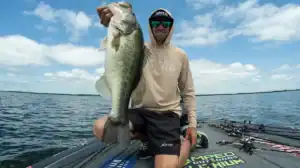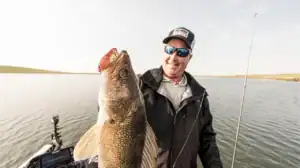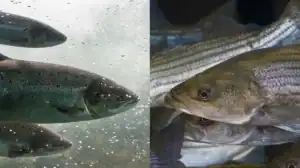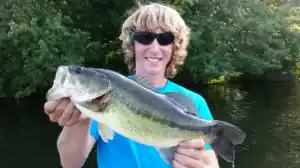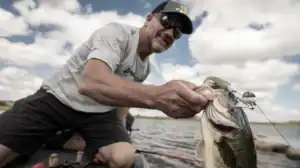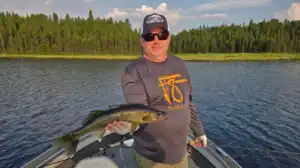North Carolina biologists are afraid that pure-strain native smallmouth, spotted and largemouth bass populations in North Carolina are being degraded and eliminated by invasive Alabama bass – creating a cautionary tale for other states nationwide.
“We’re concerned that our pure-strain smallmouth bass fishery in North Carolina soon could be gone – especially in the mountain rivers and lakes,” says Kin Hodges, a state fisheries biologist for 29 years. “Aggressive Alabama bass are much smaller than other black bass species, and in time they can hybridize and diminish larger pure-strain native bass species. That hybridization eventually will gravely impact the size of bass North Carolina anglers have historically caught.”
The invasive hybrid bass issue is a complicated fisheries management problem, in North Carolina and other states in the Southeast. It can take a decade or two for ‘Bama bass to completely take over rivers and lakes, and if they aren’t managed, they absolutely will take over and it will result in a population of significantly smaller hybridized bass.

Hodges says that sometimes, when ‘Bama bass get into a lake or river, the resulting first years of hybridization seem to show that hybrid bass are bigger. But in time the more aggressive Alabama-strain spotted bass breed continuously to diminish the larger pure strain native bass species.
Anglers may believe they’re catching larger 4- and 5-pound smallmouths from a lake today, but the fish are largely hybrid Alabama bass.
The species is often mistakenly identified as smallmouth or spotted bass by anglers because their appearance is very similar, but they are truly a separate species that can outcompete and replace native black bass. This causes a bass population to be dominated by high numbers of Alabama bass, which on average are considerably smaller than native bass.
In the coming years, the bass will become smaller, and smaller, eventually becoming virtually 100% ‘Bama bass that weigh just a pound or two on average.
Why Is This Matter So Urgent?

Alabama bass interbreed particularly fast with smallmouths and spotted bass. And within just a few years can become so engrained that native bass strains are eliminated by the more aggressive and much smaller ‘Bama bass.
Mature Alabama bass are typically 1 to 2 pounds in size. Once hybridization occurs in rivers and lakes with larger native black bass, says Hodges, a fishery that once had 5-pound smallmouths and 6- or 8-pound largemouths is doomed to eventually harbor only 2-pound-class hybridized ‘Bama bass.
The hybridization occurs more slowly in largemouth populations, especially in lakes – but it will occur, Hodges says. And the Alabama bass problem is spreading.
Hodges says they’ve crossed into Virginia waters and are spreading in many rivers and connecting lake systems. That may be the “canary in a coal mine,” perhaps foretelling bass problems in other southeastern states, and perhaps even the whole country.
“This is a cautionary tale for other states nationwide — that Alabama bass could be a potential threat to smallmouth, spotted, and largemouth fisheries everywhere,” Hodges says.
It’s a tale that folks in Tennessee are more than familiar with; that state made drastic changes to its creel limits for 2025 in light of the realization that its smallmouth population has become extremely hybridized.
Anglers Are the Key

While North Carolina fisheries staff are aggressively removing Alabama bass wherever they find them, Hodges says anglers are the key to stopping the spread of the invasive species. Fishermen are being called on to help protect the state’s larger black bass species from ‘Bama bass hybridization.
It is not possible to eradicate Alabama-strain bass where they have become established, but reducing their numbers and stopping their spread as much as possible minimizes their impact on other bass species.
While catch and release for other black bass species has been instrumental in maintaining the quality of North Carolina bass fisheries, releasing Alabama bass is not good for state waters. So, North Carolina wants anglers to harvest all Alabama bass they catch.
“Every Alabama bass that anglers keep makes room for a native bass to prosper,” says Hodges. “Once ‘Bama bass hybridize with smallmouth bass in a body of water, the problem is almost impossible to eliminate.”

Alabama-strain bass were first identified in North Carolina starting in the 1980s. It’s believed they were subsequently caught and released in other waters by anglers over the years, first showing up in Lake Chatuge and Lake Norman.
Because ‘Bama bass can be difficult to differentiate from native bass, North Carolina is aggressively posting signs with identification pictures to help anglers. The signs are installed at public boating and fishing accesses, and the information can be found on the state website.
“This is potentially a lot worse than the invasive snakehead fish species many anglers know about,” Hodges says. “The ‘Bama-bass spread could have a much more devastating impact on fishing for bass. In the foreseeable future we could lose all our big bass native species to small 1-to-2-pound Alabama bass.
“We’ve got to get our anglers educated about this threat to their bass fishing. If we can educate fishermen about the Bama bass problem, we can stop the invasive species spread to other waters.”


